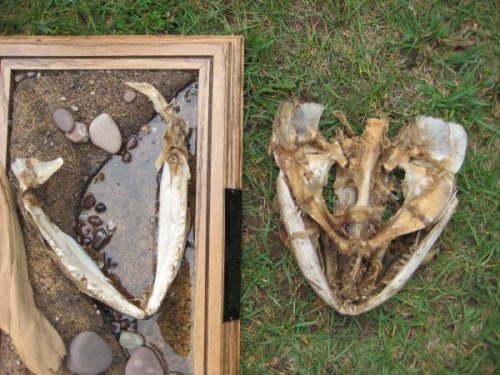New “Musky Jaws” found on the Chippewa Flowage!
On September 28th, 2008, nearly 10 years after a massive musky jawbone was discovered on Lake Chippewa Flowage another apparently larger set of Musky jaws was found by duck hunter Chris Weber.
Weber was walking along the shores of Hay Creek down from Dun Rovin‘ trying to flush some ducks when he discovered both the upper and lower jaws. Many people remember in 1998 when a monster jawbone was happened upon by a family exploring Lake Chippewa‘s “Miami Beach” Island.
Frank Pratt, Hayward Area Fisheries Manager for the Wisconsin Dept. of Natural Resources estimated that fish to probably be in the range of 58 to 70 inches based on the jaw dimensions. The new jawbone appears to be 1 1/2 to 2 inches larger. It will be sent down to fish biologists at UW Stevens Point to be analyzed.
Is the next world record Musky swimming in the waters of Lake Chippewa Flowage?

About the Musky: The musky, or muskellunge, is a remarkable freshwater fish known for its impressive size and elongated body. Native to North America, particularly the waters of the Great Lakes and parts of the upper Midwest, the musky follows a fascinating growth trajectory influenced by various environmental factors. As larvae, they begin their life cycle measuring just a few centimeters, relying on their yolk sac for nourishment. Typically within a few weeks, they transition to a voracious predatory diet, consuming smaller fish and invertebrates that occupy their aquatic habitats.
As muskies grow, they can reach lengths of up to 60 inches or more, making them one of the largest fish in North American waters. Their growth rate is notably influenced by factors such as water temperature, food availability, and habitat conditions. In environments with abundant prey and favorable conditions, muskies can grow significantly faster, often reaching trophy size within a span of 4 to 7 years. This growth pattern showcases their role as apex predators in their ecosystems, contributing to the balance of fish populations in lakes and rivers.
Muskies also undergo physical changes as they mature, developing the distinctive coloration characterized by darker bodies adorned with lighter spots or stripes, which serve as effective camouflage against predators. In addition to their striking appearance, muskies are renowned for their aggressive nature and notable fighting ability when hooked, which makes them a prized catch among anglers. The combination of their growth, predatory skills, and adaptability enables muskies to thrive in diverse aquatic environments, making them an integral part of North America’s freshwater ecosystems.

